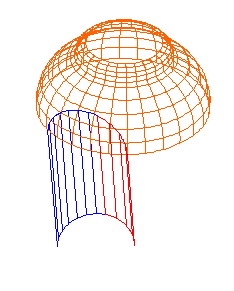Surface-surface trimming is more accurate and is the preferred method of trimming surfaces against each other.
Surface-surface trimming should be used if the intersection curve of the two surfaces is a valid trimming curve for the surface to be trimmed.
Surface-surface trimming performs surface/surface intersection as its initial step. The resulting curve is then used to trim the surfaces. This curve must be a valid trimming curve for the surfaces to be trimmed. See trimming restrictions for more information. If the intersection curve does not cut all the way across the surfaces to be trimmed, you may have to calculate the intersection curve separately and then join it with other curves to form a valid trimming curve for the surface.
Trim a surface with a curve should be used:
- If you only have a curve with which to trim a surface.
- If the surfaces are tangent at their intersection such as a fillet and its blending surfaces. In this case, extract the boundary curve of the fillet surface and use it to trim the other surface.
- Where one surface must be trimmed by multiple other surfaces before a complete loop is formed. You may need to extract trimmed edges or calculate surface-surface intersection curves and join them to create the trim loop. In this example, the orange revolved surface cannot be trimmed by either the blue or red surface alone.
 Instead:
Instead:- Create a curve at the intersection of the blue surface and the orange surface.
- Create a curve at the intersection of the red surface and the orange surface.
- Join the two curves.
- Trim the orange surface with the joined curve.